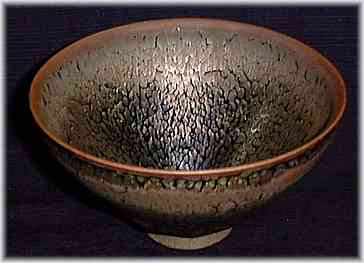According to Wolfgang Sher, the Austrian china restorer, whose china repair techniques are used by many Asian and European potters and restoration studios, believes that the greatest tenmokus are considered those on the bowls and cups produced around 10th and 11th century in China.

Tenmoku ware, called Jian ware in China, originated the Chinese province of Fujian was first made in kilns located deep in the mountains. The clay used for Jian ware was very hard, dry and course. Though popular and expensive now, were only peasant wares in China and for that reason were rarely saved. The Chinese first developed these iron glazes on stoneware and the bowls were of good enough quality to export to Japan, where they quickly became very popular, admired by potters, sculptor, and Japanese aristocracy.
During the Tan Dynasty, the tenmoku wares weren’t considered “majestic enough” for burial with the dead. During the Song Dynasty tenmokus started to become more popular and therefore more expensive, giving birth to china repair and restoration. Though primitive due to the lack of appropriate tools, the china restorers nevertheless tried to imitate the dark “oil runs” on the bowls.
In 13th century Japanese Zen priests traveled to China to study Buddhism and brought many tenmoku wares with them to Japan, where later they were used for tea ceremony by the Japanese aristocracy.
If you’re a china restorer or potter and have access to a kiln, below is a sample recipe for a tenmoku glaze a ceramic artist offered at
a recent Ceramic Conference in WashingtonDC.
Firing range cone 8-10, oxidation or reduction, medium thickness, ideal temperature 1280°C with a 45 minute soak. Any stoneware clay.
Potash feldspar: 70
Calcium borate frit: 10
Limestone (whiting): 10
China clay: 10
Red iron oxide: 10
Contact us for your ceramic repair and porcelain restoration needs.
References are available upon request.




